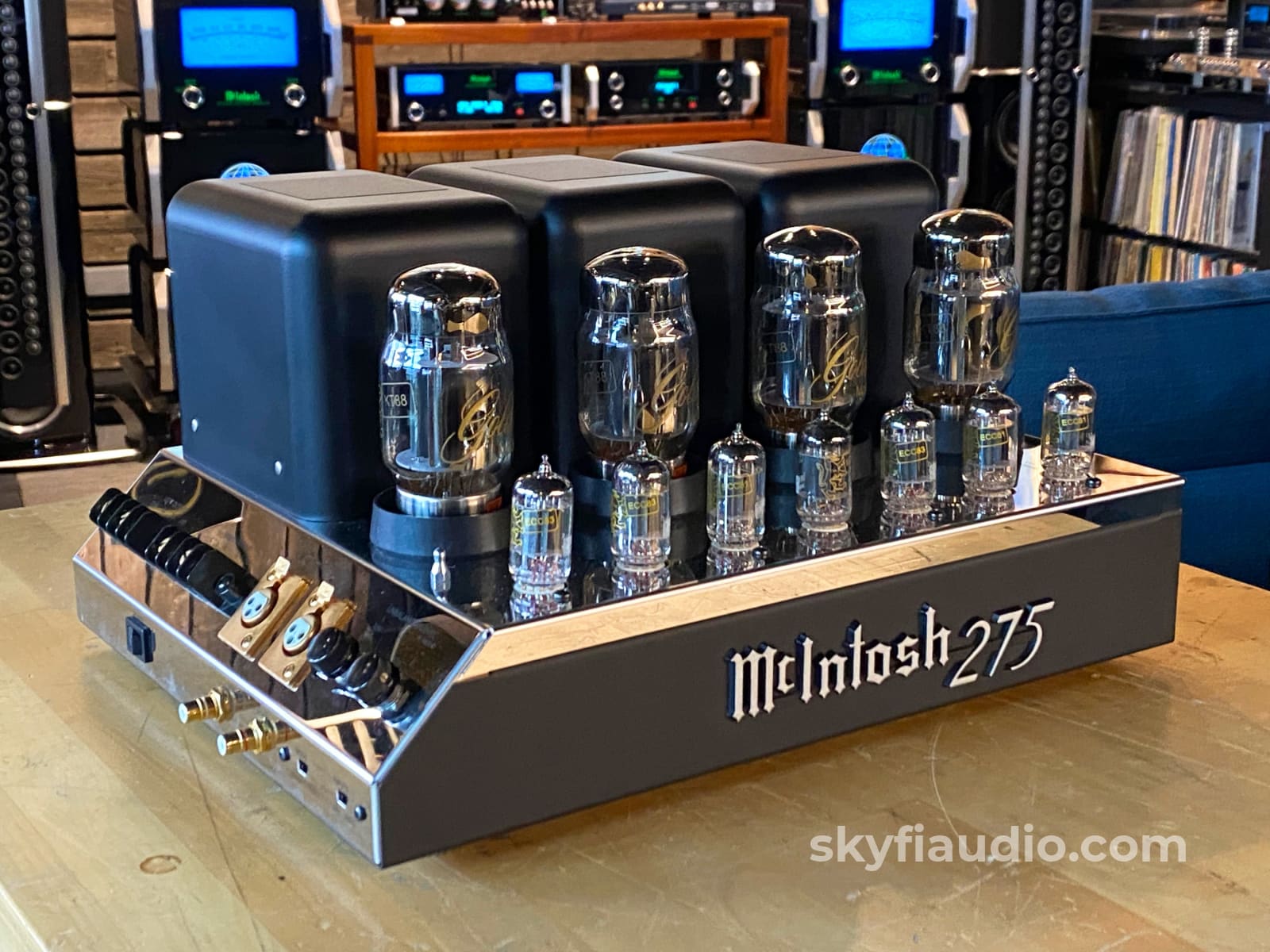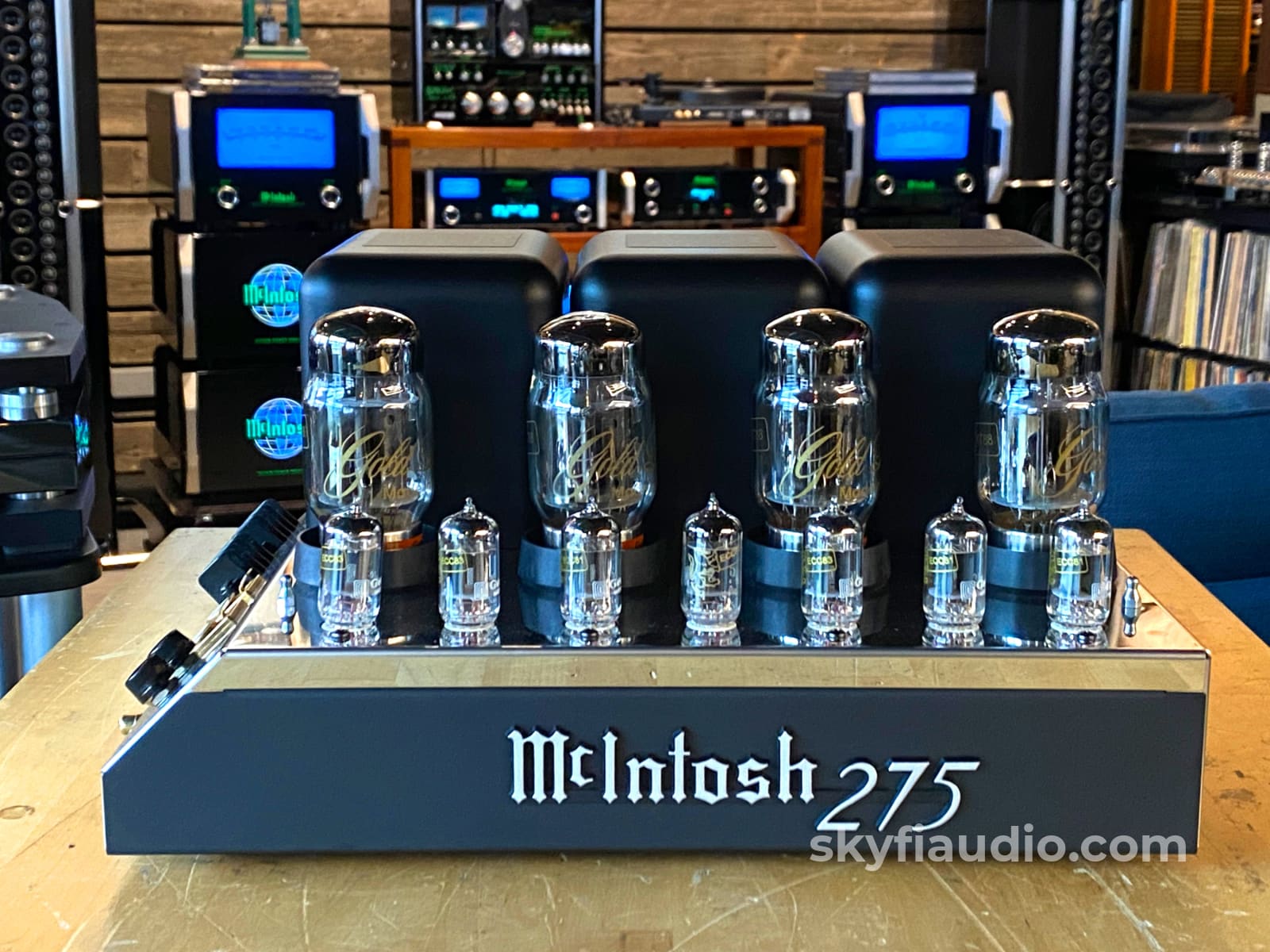














McIntosh MC275 MK IV (2004-2006) Tube Amplifier w/Gold Lion Tubes
Free Shipping on *ALL* Electronics (Excluding Speakers, Contiguous 48 US States Only)
Pickup currently unavailable at SkyFi 479

McIntosh MC275 MK IV (2004-2006) Tube Amplifier w/Gold Lion Tubes
SkyFi 479
479 South Broad Street
Glen Rock NJ 07452
United States
Great sounding and collectible amplifier from McIntosh in its MK IV (MK 4) designation which is second next to newest. Not old enough to be considered vintage, but new enough to have all the reliability benefits of the newer generation models including balanced inputs and usable speaker terminal strips.
The MK IV sounds as good, if not better than the current MK VI (MK 6), and foregoes what many think to be silly LED lighting on the tubes and the more complicated speaker binding posts.
This amplifier was also fitted with a full set of official Gold Lion branded tubes. The original tube cover "cage" is also included, and in superb condition.
Best of all it will ship in an official McIntosh box for safe travels.
Cosmetic Notes:
• Light lettering wear on connection panel.
• Very nice condition throughout with no signs of rust or tarnishing.
• Bright shiny chrome-work throughout.
• Tube case is perfect.
Brand Background:
McIntosh Laboratory is an American manufacturer of handcrafted high-end audio equipment based in Binghamton, New York. The company was founded in 1949 by Frank McIntosh. The company designs and produces audio amplifiers, stereo tuners and other consumer electronics products.
Ownership:
Single Owner
Connections:
RCA and XLR Inputs, Removable Power Cord, Screw Terminal Speaker Connectors.
Cosmetic Condition:
7/10 = Good. One or two minor scratches. Well Maintained. See our detailed rating description here.
Working Condition:
Working perfectly and tested in our lab and listening room.
Included:
Just the unit and power cord.
Packing:
Original Manufacturers Packing
Specs:
CONTROLS and CONNECTORS:
• Speaker barrier strips for 4, 8 and 16 OHMS
• XLR BALANCED INPUTS (L+R)
• RCA UNBALANCED INPUTS (L+R)
• UNBALANCED GAIN controls: 2.5V to 1.0V
• MODE Switch: MONO or STEREO
• INPUT Switch: XLR Balanced or RCA Unbalanced
TECHNICAL SPECIFICATIONS:
Power Output:
75 Watts Per Channel (Stereo Mode)
150 Watts Total Bridged (Mono Mode)
Frequency Response:
20 - 20 kHz (+0 -0.2dB)
Distortion:
0.5%
Noise & Hum:
-100 dB (A weighted)
Output Impedance:
4, 8, 16 ohms in Stereo Mode
2, 4, and 8 ohms in Mono Mode
(25 V line)
Damping Factor:
Greater than 10
Input Impedance:
100 k Unbalanced
180 k Balanced
Input Sensitivity:
1.0 V Unbalanced
2.0 V Balanced
(Unity Coupled)
Power Requirements:
120V at 400 Watts
Tube Compliment:
4 x KT88/6550 output
3 x 12AX7A
4 x 12AZ7
(Solid state rectifier Bridge)
Dimensions:
7-1/2" H, 12" W, 16" D
Weight:
67 lbs.
Approximate Age:
2005
Link to Manual:
Click Here
Recommended Cables:
Kimber Kable - RCA Interconnects - Better
Kimber Kable - RCA Interconnects - Best
Kimber Kable - BALANCED XLR Connectors - Better
Kimber Kable - BALANCED XLR Connectors - Best
Kimber Kable - Speaker Cables - Better
Kimber Summit Series Monocle XL Speaker Cables (PAIR) - Best
Kimber Summit Series BiFocal XL Bi-Wire Speaker Cables (PAIR) - Best If Applicable
Kimber Kable - Power Cords - Better
Kimber Kable - Power Cords - Best
The SkyFi Testing Process for Tube Amplifiers:
We start with a visual inspection of all internal components to make sure that there are no signs of heat stress or damage. Capacitors are checked for telltale signs of predictive failure including bulging, shrunken wrappers, or physical leakage. We also inspect resistors and other passive components for signs of overheating. If tube arcing has occurred in the past we can usually spot discoloration on the output tube sockets. On vintage units we often spot check select capacitors for value and ESR.
If the amplifier passes visual inspection, we move on to a full test of all of the tubes. We use an Amplitrex AT-1000 Tube Tester which is capable of testing both emission and Gm with a high degree of accuracy. We document the results of each tube and replace any weak or suspect tubes before proceeding. When we power on tube amplifiers for the first time we usually use a variac and current limited AC supply and slowly raise the voltage up to nominal mains level while monitoring plate, screen, filament, and negative bias supply voltages where applicable. If everything is in order we feed a low level test signal into the amplifier’s input and monitor its output on an oscilloscope across an 8 ohm dummy load. At this point we are just looking to verify basic function and confirm that the output transformers are not damaged. Once we have verified that the amplifier is safe to operate, we connected it to full mains power. For fixed bias amps we set the bias to manufacturer spec. For cathode biased amps we monitor the plate to cathode voltage to determine if the output tubes are operating in a safe range. Once the output section is verified we move onto bench evaluation.
We start by feeding the input of the amplifier with a low level 1KHz test signal, slowly increase its amplitude while monitoring the amplifier’s output on an oscilloscope for signs of noise, clipping, distortion, or improper channel balance. We continue increasing the signal level until the amplifier reaches clipping. At this point we take an output power measurement and compare it to the spec sheet of the amplifier to verify proper performance. We finish off the bench evaluation with a 1KHz square wave check and a 20Hz to 20KHz sine sweep to assess the amplifier’s frequency response characteristics. This battery of tests will usually reveal if the amplifier has any issues that need further attention.
Before the device leaves the bench, we perform a listening test with actual music using a variety of preferred test tracks. Our benches are outfitted with familiar monitor speakers which help us identify inconsistencies that will not always show up on our test gear. The main things that we are listening for are hum or noise with no signal present, proper center image, clicks, pops, or any other obvious undesirable audio characteristics.
If the unit passes all of these tests it is moved to our long term testing rig where we simulate real word operating conditions for 6-8 hours. For tube amps we like to run this test at least twice. This allows us to monitor the unit for signs of thermal runaway or intermittent issues that only crop up when it has fully come up to temperature. We find this step to be essential, especially for vintage units.
Choose options















